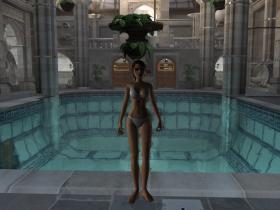Version 1.2, 29.02.2008
Why a graphics card is important for a gaming PC
Even though it's not always easy to find a bottleneck in a gaming computer, low performance is most often caused by a weak graphics card, not by a CPU or memory (unless you are really low on it.) Yes, there are some games, which are limited by a processor ("CPU-intensive") or insufficient memory in certain conditions. But gaming performance mostly depends on a graphics card. The higher graphics settings you want to use in games, the heavier will be the load and the effect on performance. This is especially about screen resolution, antialiasing and anisotropic filtering, which put all the load only on graphics cards.
Sometimes you can play modern games with old graphics cards, and they will even run rather fast. But video quality will be very low due to the lack of support for the latest video technologies. One of such games is Tomb Raider: Legend. See the visual difference between modes for old and modern graphics cards:


These look like different games! In other words you will be able to play a lot of modern games at maximum video quality only if you upgrade your graphics card. The same can be said about new Low-End graphics cards - although they suit the requirements, they are too slow to play with comfort.
We haven't touched upon situations, when a new game refuses to start up, because it requires support for some features, for example, the latest shader model. Users of ATI R3x0/R4x0 cards (ranging from RADEON 9500 to RADEON X850 XT) faced this problem in 2006 in several games, such as Splinter Cell: Double Agent and Rainbow Six: Vegas. They couldn't even start these games, because those required support for Shader Model 3.0. The only solution was to upgrade graphics cards.
So, the main point of this section is as follows: "Never save on a graphics card for a home and/or gaming computer. It's the most important PC part for modern 3D games!" When you choose a graphics card for a home PC, you should try to allocate maximum budget for a graphics card, unless you plan on buying a new graphics card in the nearest future. In this case, if you don't have enough money for a good graphics card at once, you may buy an integrated system with a dedicated slot for a discrete graphics card. In all other cases you should choose a graphics card that is the most powerful and expensive for your budget (so much the better if it exceeds your budget). Moreover, a graphics card in a gaming computer must be more expensive than a CPU.
Even though there is no ideal combination of a processor and a graphics card (except for the most powerful CPU and graphics card possible), there is still a range of optimal combinations. This combination differs from game to game, and this difference may be quite noticeable - there are more CPU-intensive games (auto simulators, real time strategies) and less CPU-intensive ones (first person shooters, arcades), where CPU and GPU loads differ much.
So, a graphics card is more important for modern games than any other PC component. It's better to have a mediocre processor and a powerful graphics card than a powerful processor and a mediocre graphics card. An acceptable minimum in early 2008 for most games is Intel Core 2 Duo E4x00, AMD Athlon 64 X2 4x00+, or better. Although games will also run well with the most powerful single-GPU processors, like Athlon 64 3800+. However, dual-core processors are recommended for most modern games. Such processors in gaming computers should be accompanied by Mid-End graphics cards, because it's unreasonable to buy a new Low-End graphcis card for 3D games, or couple such a processor with an expensive High-End solution.
These are such cards as ATI RADEON HD 3850 and GeForce 8600 GTS, disappearing ATI RADEON HD 2900 PRO or coming GeForce 9600 GT. More powerful graphics cards will be expedient only at high resolutions, where their power will be limited by low CPU performance. And low-end graphics cards are generally of little use in modern games, considering a lifespan of a fully-fledged gaming system. You may buy GeForce 8600 GT or RADEON HD 2600 XT as a last resort, but no worse!
In case of more powerful dual-core processors, like Intel Core 2 Duo E63x0-E65x0 and Athlon 64 X2 5x00+, you'd better get Upper Mid-End or Lower High-End graphics cards (price ranges are described further), at least RADEON HD 3850 and GeForce 9600 GT, maximum - GeForce 8800 GT, GeForce 8800 GTS, and RADEON HD 3870. And logically, you should choose the fastest graphics cards for the most powerful CPUs. There is no upper limit here, but the bottom limit is GeForce 8800 GTS and RADEON HD 3870. In our opinion, the optimal choice is as follows: GeForce 8800 GTS 512MB and RADEON HD 3870 X2 (even considering drawbacks of dual-GPU configurations).
Summing up the CPU/GPU balance, we can say that to make a gaming system balanced, a graphics card must be 1.7-2.5 times as expensive as a CPU. It's an approximate average, but you should heed the advice. You should also read our latest articles about the effect of CPUs on performance.
Next: Expansion slots: AGP and PCI Express
Alexei Berillo aka SomeBody Else (sbe@ixbt.com)
April 8, 2008
Write a comment below. No registration needed!


